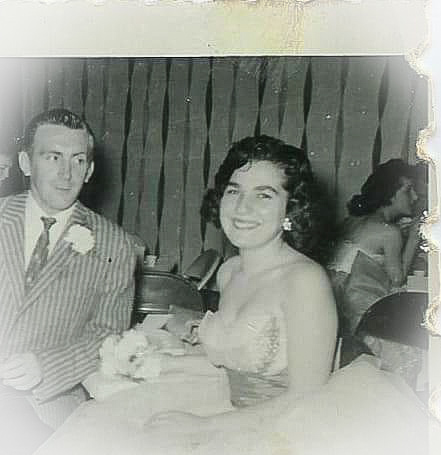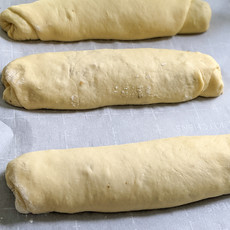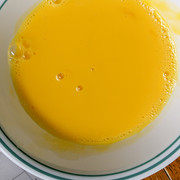Old Fashioned Nut Roll
- Nicole Rivera
- Apr 1, 2021
- 11 min read
About this Recipe
I know when people think of their favorite meals, they usually think of Thanksgiving or Christmas dinner, but I can honestly say that my favorite holiday meal was always Easter. My family is primarily made up of Irish, Polish, Syrian, and Palestinian heritage, and much of that came together to meet at the dinner table on Easter day. We would have macaroni salad, smoked kielbasa and ham with beet sweetened horseradish. There was potato salad and butter beans, pepper hash and coleslaw. Sometimes we would even have Syrian spinach or meat pies. And it wouldn't be a holiday without enough mashed potatoes to feed the entire neighborhood.
The desserts on Easter were mostly just various candies, but there was always one dessert that everyone looked forward to: nut roll. Nut roll is a golden brown loaf with swirls of sweet, ground walnut filling. This particular nut roll wasn't store-bought, but rather baked with care each year by my Grandmother's sister, Rosemary, known by all who loved her as Aunt Rhody. And she certainly was loved! She was kind, generous, had a wicked sense of humor, and boy could she bake! She would make dozens of these rolls and hand them out each year for Easter and other holidays.
Many years ago my Aunt, who has since passed away, tried to walk me through how to make this nut roll over the phone. I had moved a few hours away, so it was difficult to convene in one kitchen. To be honest...it didn't go so well. I didn't know enough about baking at that point in my life to follow the sparse directions that seasoned bakers sometimes give. I was also never told to split the dough, so I ended up with a dessert monster. Fortunately, there are no pictures to remember that by! The memory of my Aunt (and the dessert blob) came back to me as I was flipping through recipe cards, and turning pages in my cookbook deciding which recipe to make for Easter. I realized that I have learned a lot since then, and that it might be time to give it another shot.
While asking around for some nut-roll-baking tips, I learned about another fabulous baker who, unbeknownst to me, has had a massive influence on my own kitchen! When my Aunt was much younger, and in a similar stage of life to my own, she had a neighbor named Mrs. Hahn. She was a little older than my Aunt and a wonderful baker. Members of my family, who were all very young then, described her as quiet, but very kind and sweet. She shared recipes, tips, methods, and secrets with Aunt Rhody, helping her to become the wonderful baker she was. The recipes she shared, including this nut-roll recipe, have been treasured, passed down, and shared among many, many people in my family (the version of the recipe I received was written down and passed to my grandmother on several small pieces of paper).
In generously sharing her knowledge and recipes with my Aunt, Mrs. Hahn sparked changes in kitchens across multiple generations. My Aunt passed those on and taught those she loved, and that kept both of their legacies alive. In this spirit of sharing, it only feels right to continue that tradition by passing this recipe and my knowledge forward. I hope you will make and enjoy this recipe for years to come, and in this way maybe they can become part of your kitchen too.
My Process
Before you turn and run, no, you will NOT end up with a dessert monster in your oven! I won't let that happen. This recipe is actually rather simple, and if you follow the steps I provide, you will have with a delicious treat for yourself and enough to share with family and friends!
This recipe will make three large loaves. You will notice below that I have provided the measurements both in volume measurements and grams. If you don't have a scale, don't worry! My Aunt never used a scale, but sometimes people feel more comfortable with bread measurements when they are more precise. I weighed out my ingredients as I went along so I could include them here, but I have found this dough to be very forgiving, so I don't believe a scale is necessary.
I followed the written recipe, but some changes were needed as there were also some gaps in the recipe. To help me gain some additional insight, I consulted with my Uncle, who is a pizza making enthusiast and has also taken up the mantle of making the yearly nut roll, so he had some great suggestions and help to offer regarding the dough. So here are the alterations that were made from the original recipe:
I converted the amount of yeast cake to the more easily obtainable and familiar dry yeast.
I followed my Uncle's suggestion for making three loaves instead of the recipe's original direction to "take a handful of dough" because I don't know how much that is.
I also followed my Uncle's calculation for the cooking time of this new dough size (Since a cooking time and temperature weren't included in the recipe I had)
Making this recipe was MUCH easier than it was 10 years ago, but it was not without it's hang-ups. I made this through twice to troubleshoot any issues. The first time I made it, the filling burst out the sides. It wasn't particularly pretty, but there was still plenty of filling inside and they tasted great. I guessed that my dough was rolled too thin. After talking to my Uncle, we theorized that my vent holes had also sealed up somewhat forcing the filling out the sides.
On my second go-round I made sure to expand my vent holes to prevent them from sealing. I also rolled the dough thicker, which I definitely liked better. This time, although I had much less spillage, some still seeped out. The only other reason it may have done so is because I didn't have enough strength in the dough to keep all of my filling in; it may have needed to be kneaded for longer to develop the gluten. I have added my suggestion to knead for longer to the write up of this recipe to try to avoid this issue; however, I didn't test this theory because after 2 pounds of walnuts and several more slices of nut roll than any one person should eat, I have decided that the best is, indeed, the enemy of good. Rest assured that even if you don't quite achieve doughy perfection, this will be delicious! As I mentioned earlier, this is a VERY forgiving dough. Even with any mistakes I made, I ended up with three gorgeous loaves that had a great texture and were full of filling. And in my experience, people don't really care if there's a little leakage on the side when you offer them the gift of a 12 inch dessert bread.
How to Make this Recipe
You'll start by making the dough.
Combine salt and flour. If you don't have a scale, or just don't feel like weighing your flour, that's perfectly fine! Just be sure to spoon the flour into your measuring cup and don't pack it down. You don't want to accidentally end up with too much flour in your dough.
Next, combine warm milk with your yeast. I find that this step is not strictly necessary. You see it more with older recipes because in the past, yeast wasn't as reliably fresh as it is today. If your yeast is not expired, you don't need to wait for it to bloom to prove that it works. Just make sure you're using a reliable brand. I did choose to combine it with the milk, but didn't wait for it to bloom. If you prefer, you can even combine the yeast with your other dry ingredients instead. This step is totally up to you. You should, however, warm the milk because keeping your ingredients warm will speed up the rising of the dough. Make sure it's not too hot, though, or you will kill the yeast. It should feel about room temperature.
Melt vegetable shortening and sour cream together. I did this in a pot on the stove on medium-low heat. I think this is the easiest method for combining them. You don't want to skip this step for two reasons: 1.) warming your ingredients will speed rise time and 2.) combining the cold sour cream with the shortening will result in small fat globs that will be hard to combine completely into your dough.
Combine milk mixture with sour cream mixture and add eggs. The mixing method is up to you and what you have available in your kitchen. In the original recipe, it states to mix these ingredients and then pour them OVER the flour and knead it that way. You can do that, or you can do what I did, which was use a stand mixer.
If using a stand mixer, I found it easiest to start with the paddle attachment. Add the milk mixture and the sour cream mixture, add in the eggs, then add the dry ingredients a little at a time until all of it has been incorporated. Once it's well blended and the dough gets a little stiffer, switch to the dough hook for kneading. At this point mix until all of the dough has been swept up into a ball then knead it for several more minutes. I suggest 6-8 minutes to make sure you develop enough gluten. If you pick up the ball and it sort of sags between your fingers, you will need to knead it a little longer. The surface of the dough, when ready, should be perfectly smooth, soft to the touch, and hold together nicely when you lift it with one hand.
Place the dough ball in a large clean bowl, cover with plastic wrap, and allow to rise in a warm area. I did this on a nice, warm day, so my kitchen was around 77 degrees. It took about 1½ hours for my dough to double. If your kitchen is colder, you'll want to place it either in the microwave (if it fits) or another great option is the oven with the oven light on (make sure your oven is off first).
Once the dough looks like it's about ready, preheat the oven (you want it to be ready when you are), then start mixing up your filling. You won't need long. I throw my walnuts in a food processor and blitz them until they resemble very, very course sand or fine gravel (the green bowl below). If you like larger pieces, you can either crush them or blend them for a shorter amount of time. That's up to you!
Mix the sugar and honey together. When you separate the egg whites, reserve the yolks in a separate bowl; we'll use them later to create an egg wash. Add your walnuts and mix well. At this point, you should have a relatively stiff mixture. Add the hot milk. I wasn't entirely sure about why the milk had to be hot for this step, but my assumption was that it will keep the butter liquid. I made it hot to the touch using the microwave, and it worked perfectly. Add a little of the hot milk at a time until the mixture feels spreadable. I used about 1/3 cup, but the amount you need may vary depending on how course your walnuts are. Reserve the leftover milk for the egg wash.
In a small bowl, combine 1/2 cup flour with 1/4 cup powdered sugar. Spread some of this mixture on your work surface, and remove the dough from the bowl; split it into three equal sections. I like to weigh my dough and divide it up by weight to make sure they are all the same, but you can eyeball it if you don't have a scale.
Working with the first dough ball, roll it out on a floured surface into as much of a rectangle as you can manage. This doesn't have to be perfect, but the closer to a rectangle you can get, the easier it will be to roll. Roll it out to about 1/8 inch thickness. Scoop about 1 cup of filling onto your dough sheet and use a spatula to spread it out toward the edges. You want to get as close to the edges as possible leaving about 1/2 inch all the way around so it doesn't ooze out the sides when you roll it.
Starting from the bottom, roll the dough upward like you're rolling a sleeping bag until you get to the top. Place the log seam side down (that's where the top edge of the dough forms a line down the log), and locate the ends of the log. Pinch the edges together and then push the whole puckered portion into the log. This is called the bellybutton and that's exactly what it will look like when you're finished. Do the same on the other side and then set it on a baking sheet lined with parchment.
Do the same with the remaining two dough balls then allow the finished loaves to rest, equally spaced, on the baking sheet for about 20 minutes, or until a skin has formed on the outside of the dough. You'll know this has happened because it will lose it's shine and will no longer be tacky when touched. I know this seems like a long time to have your oven on, but you want it to be hot. This will give it enough time to evenly heat up for the best baking result.
When the loaves are ready for the oven, grab the egg yolks you set aside earlier and add a little of the leftover milk you used for the filling-just enough to make the yolks into a runny liquid when you mix them. I only needed about 2 or 3 tablespoons of milk. Use a pastry or basting brush and brush all three logs with the egg and milk mixture. You want them to be evenly coated. Finally, using a sharp knife or kitchen shears, cut vent holes in the top of the loaves. I use the tip of my knife or my finger to open them slightly to make sure they don't seal up in the oven.
Place them in the oven to bake for 35-40 minutes. They are finished when the crust is a even, deep, golden brown. Transfer to a cooling rack, and wait until they have cooled before cutting in to them.
Old Fashioned Nut Roll
Ingredients
3 Cups AP flour (404g)
½ Tsp kosher salt
½ Cup whole milk, warmed (120g)
¼ Yeast cake (½ oz) or 5g dry yeast (about 1½ tsp)
½ Cup vegetable shortening (84g)
½ Cup full fat sour cream (115g)
2 Large eggs
For Filling
2 Egg whites (yolks reserved)
1 Cup granulated sugar
2 Tbsp liquid honey
1 lb Shelled walnuts, ground
3 Tbsp unsalted butter, melted
¾ Cup whole milk, hot
For Rolling
½ Cup AP flour
¼ Cup powdered sugar
Dough Instructions
In a bowl combine flour and salt; mix.
To the warm milk (not too hot), add your yeast; stir well. Cover and set aside until it activates (blooms).
In a pot on medium low heat, melt vegetable shortening and sour cream.
In a large bowl (or stand mixer using the paddle attachment) combine sour cream mixture with the milk mixture; add eggs and combine.
If kneading by hand, pour this mixture over your flour mixture and knead until smooth.
If using a stand mixer, add the flour a little at a time until the mixture because thick. Switch to the dough hook and knead for several minutes (about 6) until the dough is cohesive and smooth.
Place dough ball in a clean bowl, cover in plastic, and set aside to rise until double.
When dough is about double, preheat your oven to 375 F.
Filling and Rolling Instructions
Combine walnuts, egg whites, honey and sugar.
Add melted butter.
Add hot milk a little at a time just until the mixture is workable/spreadable (I used about ⅓ cup). Set aside the leftover milk for egg wash.
In a small bowl, combine ½ cup flour with ¼ cup powdered sugar. Use this mixture to flour your work surface.
Split the risen dough into three equal balls.
Flour your work surface and roll out the first ball into a rectangle about ⅛ inch thick.
Scoop one cup of filling onto the dough surface and spread it equally leaving about ½ inch boarder on the edges.
Starting from the bottom of the dough, roll up until you get to the top.
Form a "bellybutton" on the ends by pinching the sides and then poking them into the center of the log.
Repeat this with the other two dough balls.
Allow the rolled loaves to rest evenly spaced (they will expand a bit in the oven) on a parchment lined baking sheet for about 20 minutes, or until a skin forms on the dough.
Combine your reserved egg yolks with a few tablespoons of leftover milk to form a runny mixture.
Brush the mixture on the outside of the logs using a pastry or basting brush.
Using a knife or kitchen shears, slice several small holes across the top of each loaf to vent steam from the filling. Widen them with your finger or a knife if necessary to prevent them from sealing up in the oven.
Bake for 35-40 minutes. The rolls are finished when they are deeply golden brown on top.
A special thank you to my wonderful Uncle Bill who always has time to talk to me about bread, pizza, and all things food. Without his help, this post would not have happened. And another big thank you to Mrs. Hahn's Grandson, Brian, who sent the beautiful picture of his Grandmother to help me (and you) know this incredible baker a little better.






























































